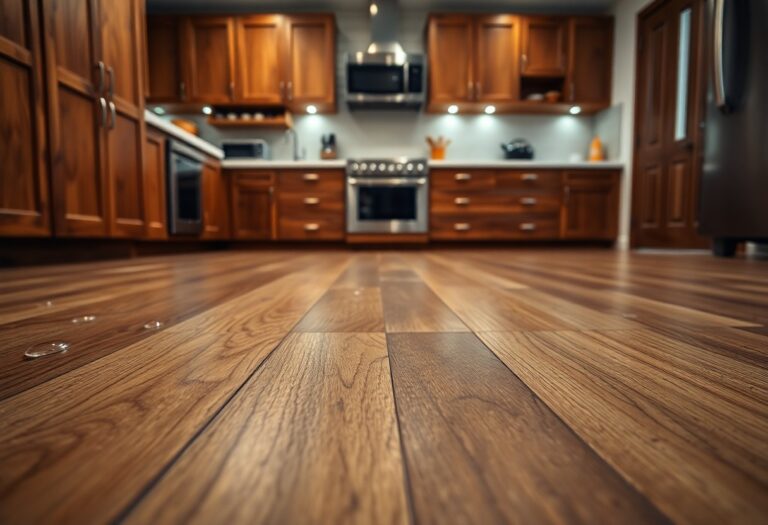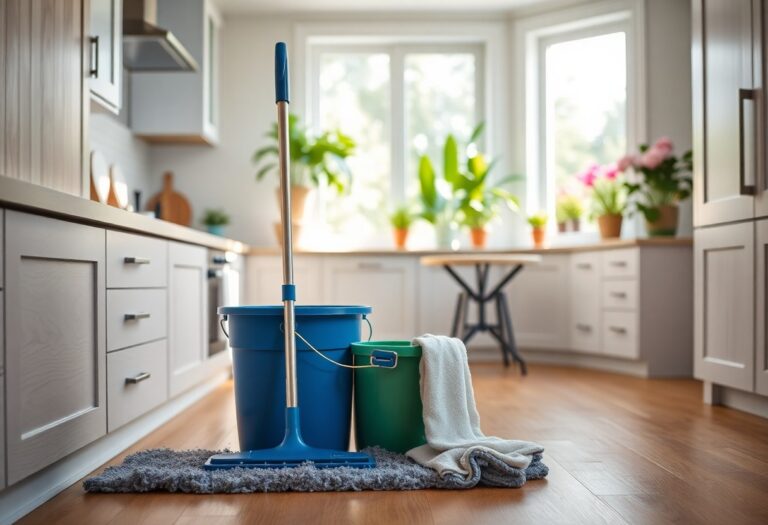Over the years, many homeowners in Kitchener have become increasingly concerned about the environmental impact of their choices, particularly when it comes to flooring. If you’re looking to enhance your home with sustainable materials, this guide will explore eco-friendly hardwood and laminate flooring options that align with your commitment to sustainability without compromising on style or functionality. Discover how you can make a positive impact while enjoying beautiful flooring in your space.

The Eco-Impact of Flooring Materials
Evaluating the eco-impact of flooring materials involves examining their origins, manufacturing processes, and ultimate disposal. Sustainable options, like responsibly sourced hardwood and eco-friendly laminate, often use fewer toxic chemicals and have lower energy requirements during production. Engaging with suppliers who prioritize sustainability can significantly reduce your home’s ecological footprint.
Carbon Footprint Analysis
In assessing the carbon footprint of flooring materials, hardwood tends to have a lower footprint than alternatives like vinyl or non-recyclable laminates. Sustainable hardwood harvested from well-managed forests ensures that trees are replanted, which sequesters carbon over time. Opting for local suppliers further reduces transportation emissions, making your flooring choice even more environmentally friendly.
Lifespan and Environmental Cost
The lifespan of your flooring plays a significant role in its environmental impact. Higher quality hardwood typically lasts decades, reducing the need for replacements and minimizing waste. For instance, solid hardwood can remain functional for a century with proper care, whereas low-quality laminate may require replacement every 10-15 years. Investing in durable flooring can lead to fewer resources consumed in manufacturing and disposal, creating a positive net effect on the environment.
Choosing flooring with a longer lifespan not only benefits your wallet but also lowers the ecological costs associated with production and waste. For example, while initial costs for sustainable hardwood may be higher, the longevity and durability can outweigh these upfront expenses by reducing the frequency of replacements. This means fewer trees cut down and less energy consumed in producing new materials. Long-lasting options, therefore, contribute to a more sustainable home, offering both environmental and economic advantages.
Sustainable Hardwood: A Greener Choice
Sourcing sustainable hardwood involves looking for wood that comes from responsibly managed forests, ensuring that new trees are planted to replace those harvested. By opting for certified wood species, you contribute to advancing forest health and reducing your carbon footprint in your Kitchener home. Sustainable options help preserve ecosystems while providing robust and beautiful flooring solutions.
Sourcing and Certification Standards
Understanding the different certification standards, such as the Forest Stewardship Council (FSC) and the Sustainable Forestry Initiative (SFI), is important for making informed choices. These organizations ensure that the wood you purchase is sourced from forests that provide environmental, social, and economic benefits. When you choose certified flooring, you are supporting sustainable practices and responsible forestry efforts.
Types of Eco-Friendly Hardwood Options
There is an array of eco-friendly hardwood options that cater to both aesthetic and environmental needs. Popular choices include bamboo, which grows quickly and replenishes rapidly, and reclaimed wood, which repurposes existing materials, minimizing waste. Other options include domestically sourced trees, such as maple or oak, which require less energy for transportation, and are often harvested sustainably. By investing in these choices, you can maintain a beautiful interior while embracing sustainability.
| Eco-Friendly Hardwood Types | Features |
|---|---|
| Bamboo | Rapid growth, renewable resource |
| Reclaimed Wood | Reduces waste, unique character |
| Maple | Strong and durable, locally sourced |
| Oak | Timeless appeal, sustainable harvesting |
| Cherry | Rich color, often sourced sustainably |
These eco-friendly hardwood options not only align with sustainability goals but also offer beautiful aesthetics that enhance your home’s ambiance. Since each type of wood has distinct characteristics, you can select one that best fits your lifestyle and design preferences. From the rich hues of cherry to the strength of oak, there’s a sustainable hardwood choice tailored just for you.
- Thou shall consider durability and maintenance needs when selecting your eco-friendly hardwood.
| Considerations for Selection | Details |
|---|---|
| Durability | Choose a wood suitable for your lifestyle |
| Maintenance | Assess the upkeep required for each type |
| Color Preference | Select shades that complement your decor |
| Cost | Evaluate budget constraints while shopping |
| Environmental Impact | Opt for reclaimed or locally sourced materials |
- Thou shall prioritize your personal style while being eco-conscious in your flooring choices.
The Rise of Laminate: Affordability Meets Sustainability
As homeowners seek budget-friendly yet sustainable flooring solutions, laminate has surged in popularity. This versatile material mimics the look of natural wood while utilizing less resource-intensive manufacturing methods. Its affordability does not compromise its durability, making it an attractive choice for families and eco-conscious individuals alike.
Manufacturing Practices and Materials
Laminate flooring is typically made from high-density fiberboard (HDF), which often incorporates recycled wood fibers. The process involves binding these fibers with resins, resulting in a lower carbon footprint compared to traditional hardwood. Many manufacturers now focus on using water-based adhesives and finishes, ensuring that volatile organic compounds (VOCs) are minimized, making laminate a healthier choice for your home.
Long-Term Benefits of Laminate Flooring
Opting for laminate flooring not only enhances aesthetic appeal but also offers significant long-term advantages. With a lifespan of 15 to 25 years, laminate is designed to withstand high traffic, resist scratches, and maintain its charm. Its low maintenance requirements help keep your home looking great without overwhelming upkeep. Additionally, the energy-efficient production process means you’re making a responsible choice for the environment.
Investing in laminate flooring pays off in various ways. You’ll save on installation and maintenance costs, as it typically requires less care than hardwood. The ease of cleaning and resistance to stains means your space remains welcoming and visually appealing. Thanks to advancements in technology, laminate now comes in various styles that can fit any home aesthetic, from rustic to modern. The blend of style, sustainability, and savings makes laminate an unbeatable choice for conscientious homeowners like yourself.
Aesthetic Appeal vs. Environmental Responsibility
Choosing flooring often requires a balancing act between aesthetic appeal and environmental responsibility. Your home’s interior style should reflect your personality, while also considering the environmental impact of your choices. Sustainable materials, like certified hardwood or eco-friendly laminate, provide options that marry visual beauty with a lower carbon footprint, ensuring your space looks stunning without compromising the planet.
Design Trends in Eco-Friendly Flooring
Current design trends emphasize natural looks and textures, driving a surge in the popularity of eco-friendly flooring. You might notice an inclination towards distressed finishes and earthy tones that highlight wood’s organic charm. Planks are increasingly being offered in wide sizes and matte finishes, giving spaces a modern yet timeless feel. Additionally, patterned laminate options replicate the aesthetics of natural woods, allowing for endless creativity in design without the environmental trade-off.
Balancing Style with Sustainability
Balancing style with sustainability nowadays is achievable without sacrificing charm or personality in your home. Recognizing certifications such as FSC (Forest Stewardship Council) will guide you in choosing hardwood that meets strict environmental standards while offering a variety of gorgeous options. Furthermore, modern laminate products often include recycled materials, marrying innovation with attractiveness, ensuring your flooring complements your décor while being responsibly sourced.
Exploring the possibilities of sustainable flooring isn’t just about making compromises; it’s about discovering beautiful materials that elevate your space. For instance, reclaimed wood, full of character, provides a unique story to your flooring and is more eco-friendly than newly harvested options. For a contemporary touch, look for companies using advanced technology to create laminate flooring that mimics the intricate designs of hardwood. This allows you to achieve a stylish and contemporary look while being a responsible consumer. Your choices can reflect not only what you love but also your commitment to a healthier planet.
Choosing the Right Option for Your Kitchener Home
Evaluating the right flooring option for your Kitchener home involves assessing your specific needs and lifestyle. Are you seeking warmth and beauty with hardwood, or do you prefer the versatility and durability of laminate? Factor in not only aesthetics but also how your choice aligns with sustainability goals, maintenance commitments, and how often you entertain. By creating a clear prioritization list of what matters most to you, commenceing on your new flooring journey will become clearer and more streamlined.
Practical Considerations: Installation and Maintenance
Installation and maintenance play a significant role in your flooring decision. Hardwood often requires professional installation due to its susceptibility to moisture and the need for a precise fit, while laminate can be a DIY-friendly choice for those looking to save on labor costs. Both options need regular upkeep, but laminate is typically easier to clean and maintains its appearance longer. Understanding your capacity for care will help you make a confident choice.
Budgeting for Sustainable Flooring Choices
Your budget is a vital factor when selecting sustainable flooring. Sustainable hardwood can range from $5 to $12 per square foot, while durable laminate can cost between $2 to $5, offering a more affordable avenue without sacrificing eco-friendly principles. Factor in not just the initial costs but the longevity and resale value of the materials, as investing in high-quality options can prove to be economical in the long run.
When budgeting, consider the total costs, including installation, maintenance, and potential future repairs or replacements. Sustainable hardwood, though higher upfront, often lasts a lifetime when properly cared for, while laminate may need replacing sooner depending on wear and tear. Additionally, look for local suppliers that offer discounts or promotions on eco-friendly products, which can further alleviate costs while still enabling you to make responsible choices for your flooring needs.
Summing up
To wrap up, as you explore eco-friendly flooring options for your Kitchener home, consider the benefits of sustainable hardwood and laminate choices. By selecting materials that prioritize environmental responsibility, you not only enhance the aesthetic of your space but also contribute to a healthier planet. Each option offers unique advantages, from durability to ease of maintenance, allowing you to create a stylish and sustainable living environment. Make informed decisions that align with your values and elevate your home’s appeal.





